MITS5505 Knowledge Management: Case Study Analysis and Solutions
VerifiedAdded on 2022/10/31
|12
|2767
|93
Homework Assignment
AI Summary
This assignment addresses key concepts in knowledge management through a case study analysis and practical exercises. It begins with a brainstorming session on enhancing employee personal worth, exploring solutions beyond monetary incentives. The assignment then applies the nominal group technique to identify the best solution, with a consensus reached on the most effective approach. Further, it delves into knowledge codification by developing frames for various entities and analyzing the most successful approach to knowledge development. Finally, the assignment critically evaluates the failure of knowledge management implementation in a global company, examining the process through five distinct stages and identifying key areas of deficiency. The solution provides a comprehensive understanding of knowledge management principles and their application in real-world scenarios.
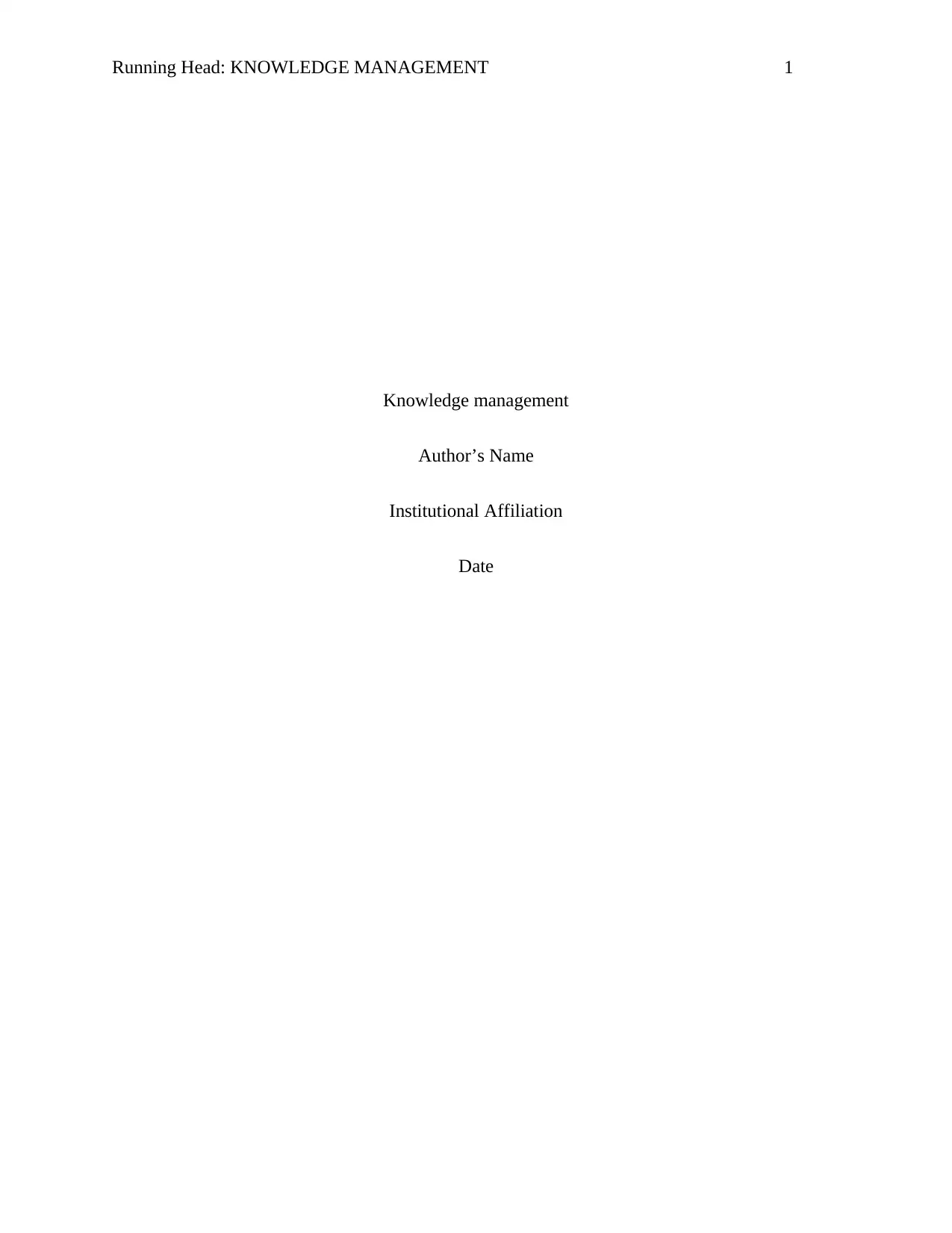
Running Head: KNOWLEDGE MANAGEMENT 1
Knowledge management
Author’s Name
Institutional Affiliation
Date
Knowledge management
Author’s Name
Institutional Affiliation
Date
Paraphrase This Document
Need a fresh take? Get an instant paraphrase of this document with our AI Paraphraser
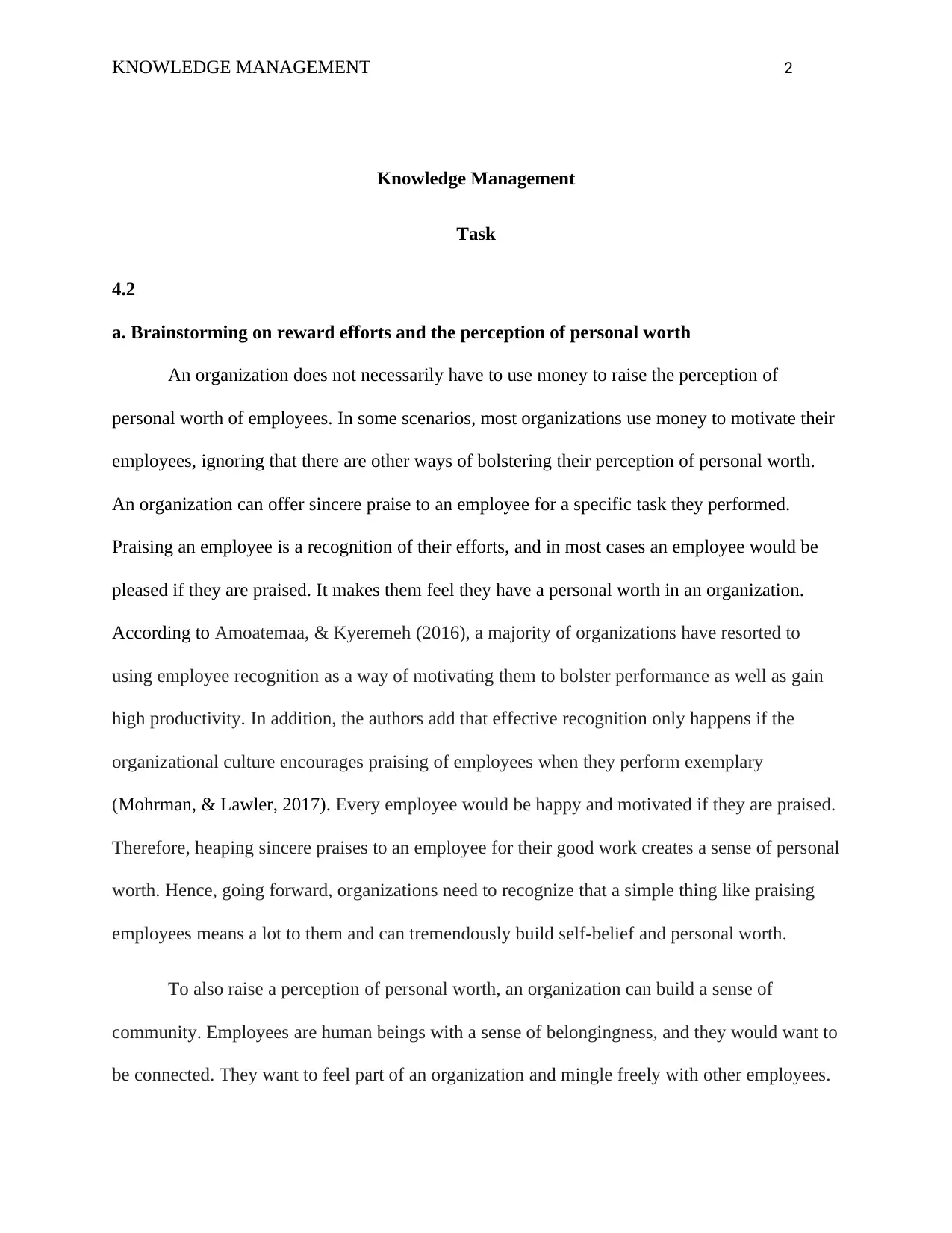
KNOWLEDGE MANAGEMENT 2
Knowledge Management
Task
4.2
a. Brainstorming on reward efforts and the perception of personal worth
An organization does not necessarily have to use money to raise the perception of
personal worth of employees. In some scenarios, most organizations use money to motivate their
employees, ignoring that there are other ways of bolstering their perception of personal worth.
An organization can offer sincere praise to an employee for a specific task they performed.
Praising an employee is a recognition of their efforts, and in most cases an employee would be
pleased if they are praised. It makes them feel they have a personal worth in an organization.
According to Amoatemaa, & Kyeremeh (2016), a majority of organizations have resorted to
using employee recognition as a way of motivating them to bolster performance as well as gain
high productivity. In addition, the authors add that effective recognition only happens if the
organizational culture encourages praising of employees when they perform exemplary
(Mohrman, & Lawler, 2017). Every employee would be happy and motivated if they are praised.
Therefore, heaping sincere praises to an employee for their good work creates a sense of personal
worth. Hence, going forward, organizations need to recognize that a simple thing like praising
employees means a lot to them and can tremendously build self-belief and personal worth.
To also raise a perception of personal worth, an organization can build a sense of
community. Employees are human beings with a sense of belongingness, and they would want to
be connected. They want to feel part of an organization and mingle freely with other employees.
Knowledge Management
Task
4.2
a. Brainstorming on reward efforts and the perception of personal worth
An organization does not necessarily have to use money to raise the perception of
personal worth of employees. In some scenarios, most organizations use money to motivate their
employees, ignoring that there are other ways of bolstering their perception of personal worth.
An organization can offer sincere praise to an employee for a specific task they performed.
Praising an employee is a recognition of their efforts, and in most cases an employee would be
pleased if they are praised. It makes them feel they have a personal worth in an organization.
According to Amoatemaa, & Kyeremeh (2016), a majority of organizations have resorted to
using employee recognition as a way of motivating them to bolster performance as well as gain
high productivity. In addition, the authors add that effective recognition only happens if the
organizational culture encourages praising of employees when they perform exemplary
(Mohrman, & Lawler, 2017). Every employee would be happy and motivated if they are praised.
Therefore, heaping sincere praises to an employee for their good work creates a sense of personal
worth. Hence, going forward, organizations need to recognize that a simple thing like praising
employees means a lot to them and can tremendously build self-belief and personal worth.
To also raise a perception of personal worth, an organization can build a sense of
community. Employees are human beings with a sense of belongingness, and they would want to
be connected. They want to feel part of an organization and mingle freely with other employees.

KNOWLEDGE MANAGEMENT 3
In building a sense of community, employee status should determine how employees connect to
each other. Once this sense of community is built not necessarily for business, employees would
in all probability increase perception of personal worth (Garrett, Spreitzer, & Bacevice, 2017).
Offering employees flexibility is one way of rewarding efforts as well as increasing
perception of personal worth. Oftentimes, employers forget that employees have families and
friends they want to spend time with. Some employers ignore completely the importance of
work-life balance and overwork employees. This in turn, denies employees work-life balance.
However, if an employer opts to create a healthy work-life balance for their employees, it would
in some way increase their perception of personal worth. Alegre, & Pasamar (2018) researched
work-life balance and firm innovativeness to investigate how the two are related. They noted that
innovativeness in most cases in firms is technology-based. However, in this research they sought
to link innovativeness to people, and discovered that work-life balance is an innovative indicator.
If an organization creatively develops work-life balance, employees will feel that their employer
cares about them as well as their families. This would in effect make them believe that they are
worthy and important to the organization.
In some circumstances, an organization can reward an effort by promoting an employee.
In most cases a promotion comes with privileges and a pay hike, but it may not be the case in
some scenarios. A low-ranking employee can be promoted to a supervisory position for being
hardworking and highly productive. However, the supervisory position given to such an
employee would be a promotion that will come with some privileges. First, it would be a
privilege for such an employee to hold a higher office than his colleagues. Also, the promoted
employee would be making decisions as someone senior in an organization. There are employees
who value high positions in their workplace and to them what is important is holding a senior
In building a sense of community, employee status should determine how employees connect to
each other. Once this sense of community is built not necessarily for business, employees would
in all probability increase perception of personal worth (Garrett, Spreitzer, & Bacevice, 2017).
Offering employees flexibility is one way of rewarding efforts as well as increasing
perception of personal worth. Oftentimes, employers forget that employees have families and
friends they want to spend time with. Some employers ignore completely the importance of
work-life balance and overwork employees. This in turn, denies employees work-life balance.
However, if an employer opts to create a healthy work-life balance for their employees, it would
in some way increase their perception of personal worth. Alegre, & Pasamar (2018) researched
work-life balance and firm innovativeness to investigate how the two are related. They noted that
innovativeness in most cases in firms is technology-based. However, in this research they sought
to link innovativeness to people, and discovered that work-life balance is an innovative indicator.
If an organization creatively develops work-life balance, employees will feel that their employer
cares about them as well as their families. This would in effect make them believe that they are
worthy and important to the organization.
In some circumstances, an organization can reward an effort by promoting an employee.
In most cases a promotion comes with privileges and a pay hike, but it may not be the case in
some scenarios. A low-ranking employee can be promoted to a supervisory position for being
hardworking and highly productive. However, the supervisory position given to such an
employee would be a promotion that will come with some privileges. First, it would be a
privilege for such an employee to hold a higher office than his colleagues. Also, the promoted
employee would be making decisions as someone senior in an organization. There are employees
who value high positions in their workplace and to them what is important is holding a senior
⊘ This is a preview!⊘
Do you want full access?
Subscribe today to unlock all pages.

Trusted by 1+ million students worldwide
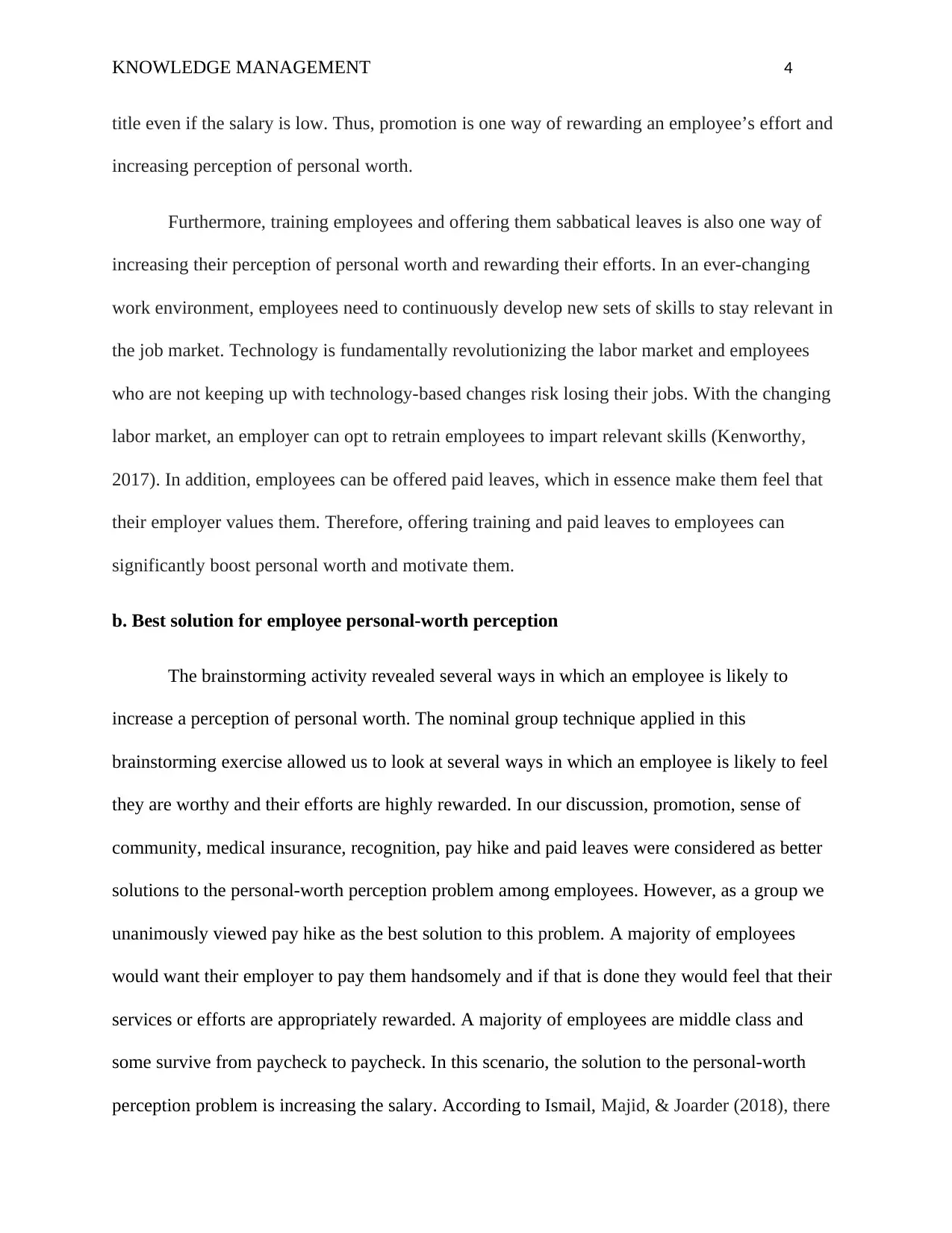
KNOWLEDGE MANAGEMENT 4
title even if the salary is low. Thus, promotion is one way of rewarding an employee’s effort and
increasing perception of personal worth.
Furthermore, training employees and offering them sabbatical leaves is also one way of
increasing their perception of personal worth and rewarding their efforts. In an ever-changing
work environment, employees need to continuously develop new sets of skills to stay relevant in
the job market. Technology is fundamentally revolutionizing the labor market and employees
who are not keeping up with technology-based changes risk losing their jobs. With the changing
labor market, an employer can opt to retrain employees to impart relevant skills (Kenworthy,
2017). In addition, employees can be offered paid leaves, which in essence make them feel that
their employer values them. Therefore, offering training and paid leaves to employees can
significantly boost personal worth and motivate them.
b. Best solution for employee personal-worth perception
The brainstorming activity revealed several ways in which an employee is likely to
increase a perception of personal worth. The nominal group technique applied in this
brainstorming exercise allowed us to look at several ways in which an employee is likely to feel
they are worthy and their efforts are highly rewarded. In our discussion, promotion, sense of
community, medical insurance, recognition, pay hike and paid leaves were considered as better
solutions to the personal-worth perception problem among employees. However, as a group we
unanimously viewed pay hike as the best solution to this problem. A majority of employees
would want their employer to pay them handsomely and if that is done they would feel that their
services or efforts are appropriately rewarded. A majority of employees are middle class and
some survive from paycheck to paycheck. In this scenario, the solution to the personal-worth
perception problem is increasing the salary. According to Ismail, Majid, & Joarder (2018), there
title even if the salary is low. Thus, promotion is one way of rewarding an employee’s effort and
increasing perception of personal worth.
Furthermore, training employees and offering them sabbatical leaves is also one way of
increasing their perception of personal worth and rewarding their efforts. In an ever-changing
work environment, employees need to continuously develop new sets of skills to stay relevant in
the job market. Technology is fundamentally revolutionizing the labor market and employees
who are not keeping up with technology-based changes risk losing their jobs. With the changing
labor market, an employer can opt to retrain employees to impart relevant skills (Kenworthy,
2017). In addition, employees can be offered paid leaves, which in essence make them feel that
their employer values them. Therefore, offering training and paid leaves to employees can
significantly boost personal worth and motivate them.
b. Best solution for employee personal-worth perception
The brainstorming activity revealed several ways in which an employee is likely to
increase a perception of personal worth. The nominal group technique applied in this
brainstorming exercise allowed us to look at several ways in which an employee is likely to feel
they are worthy and their efforts are highly rewarded. In our discussion, promotion, sense of
community, medical insurance, recognition, pay hike and paid leaves were considered as better
solutions to the personal-worth perception problem among employees. However, as a group we
unanimously viewed pay hike as the best solution to this problem. A majority of employees
would want their employer to pay them handsomely and if that is done they would feel that their
services or efforts are appropriately rewarded. A majority of employees are middle class and
some survive from paycheck to paycheck. In this scenario, the solution to the personal-worth
perception problem is increasing the salary. According to Ismail, Majid, & Joarder (2018), there
Paraphrase This Document
Need a fresh take? Get an instant paraphrase of this document with our AI Paraphraser
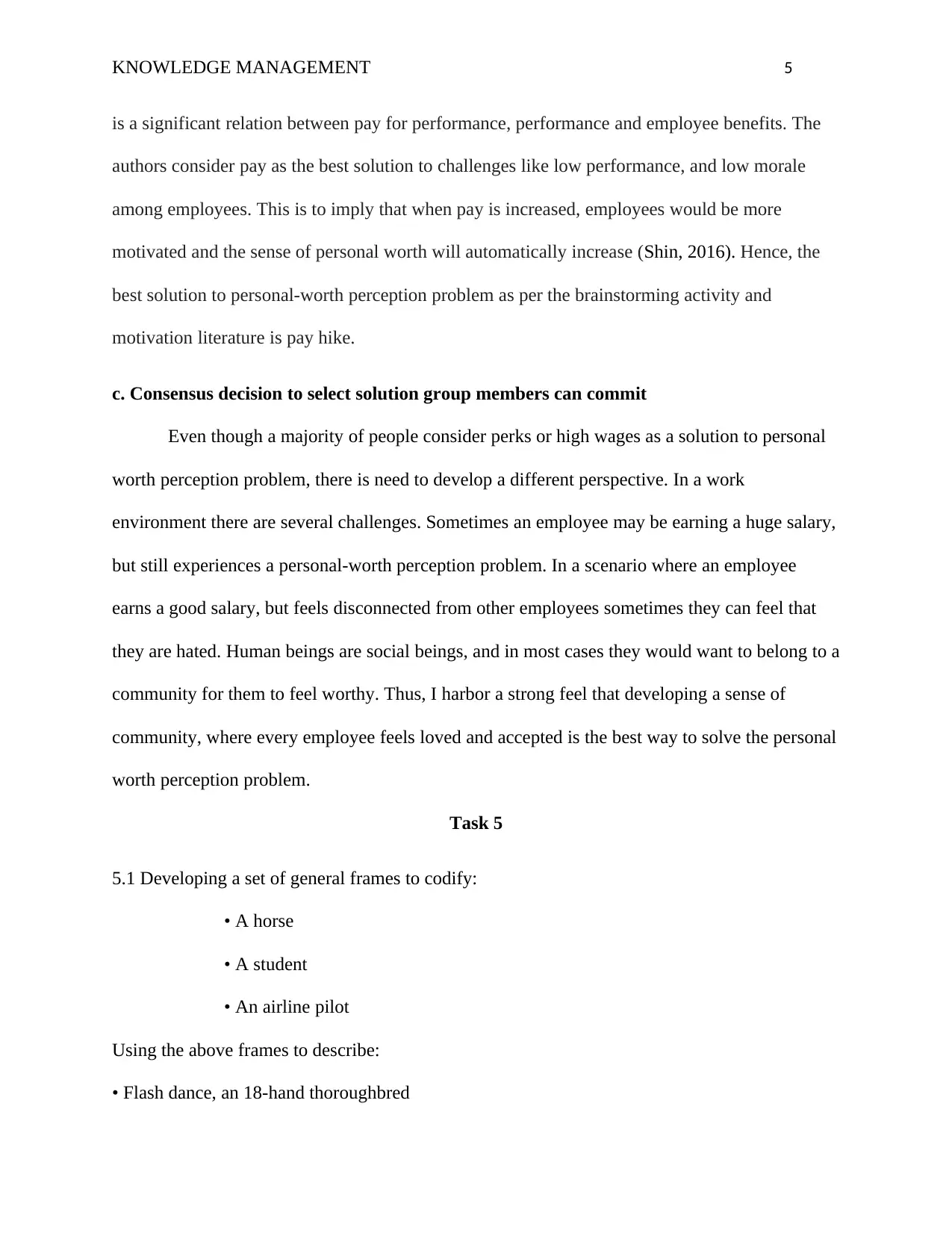
KNOWLEDGE MANAGEMENT 5
is a significant relation between pay for performance, performance and employee benefits. The
authors consider pay as the best solution to challenges like low performance, and low morale
among employees. This is to imply that when pay is increased, employees would be more
motivated and the sense of personal worth will automatically increase (Shin, 2016). Hence, the
best solution to personal-worth perception problem as per the brainstorming activity and
motivation literature is pay hike.
c. Consensus decision to select solution group members can commit
Even though a majority of people consider perks or high wages as a solution to personal
worth perception problem, there is need to develop a different perspective. In a work
environment there are several challenges. Sometimes an employee may be earning a huge salary,
but still experiences a personal-worth perception problem. In a scenario where an employee
earns a good salary, but feels disconnected from other employees sometimes they can feel that
they are hated. Human beings are social beings, and in most cases they would want to belong to a
community for them to feel worthy. Thus, I harbor a strong feel that developing a sense of
community, where every employee feels loved and accepted is the best way to solve the personal
worth perception problem.
Task 5
5.1 Developing a set of general frames to codify:
• A horse
• A student
• An airline pilot
Using the above frames to describe:
• Flash dance, an 18-hand thoroughbred
is a significant relation between pay for performance, performance and employee benefits. The
authors consider pay as the best solution to challenges like low performance, and low morale
among employees. This is to imply that when pay is increased, employees would be more
motivated and the sense of personal worth will automatically increase (Shin, 2016). Hence, the
best solution to personal-worth perception problem as per the brainstorming activity and
motivation literature is pay hike.
c. Consensus decision to select solution group members can commit
Even though a majority of people consider perks or high wages as a solution to personal
worth perception problem, there is need to develop a different perspective. In a work
environment there are several challenges. Sometimes an employee may be earning a huge salary,
but still experiences a personal-worth perception problem. In a scenario where an employee
earns a good salary, but feels disconnected from other employees sometimes they can feel that
they are hated. Human beings are social beings, and in most cases they would want to belong to a
community for them to feel worthy. Thus, I harbor a strong feel that developing a sense of
community, where every employee feels loved and accepted is the best way to solve the personal
worth perception problem.
Task 5
5.1 Developing a set of general frames to codify:
• A horse
• A student
• An airline pilot
Using the above frames to describe:
• Flash dance, an 18-hand thoroughbred
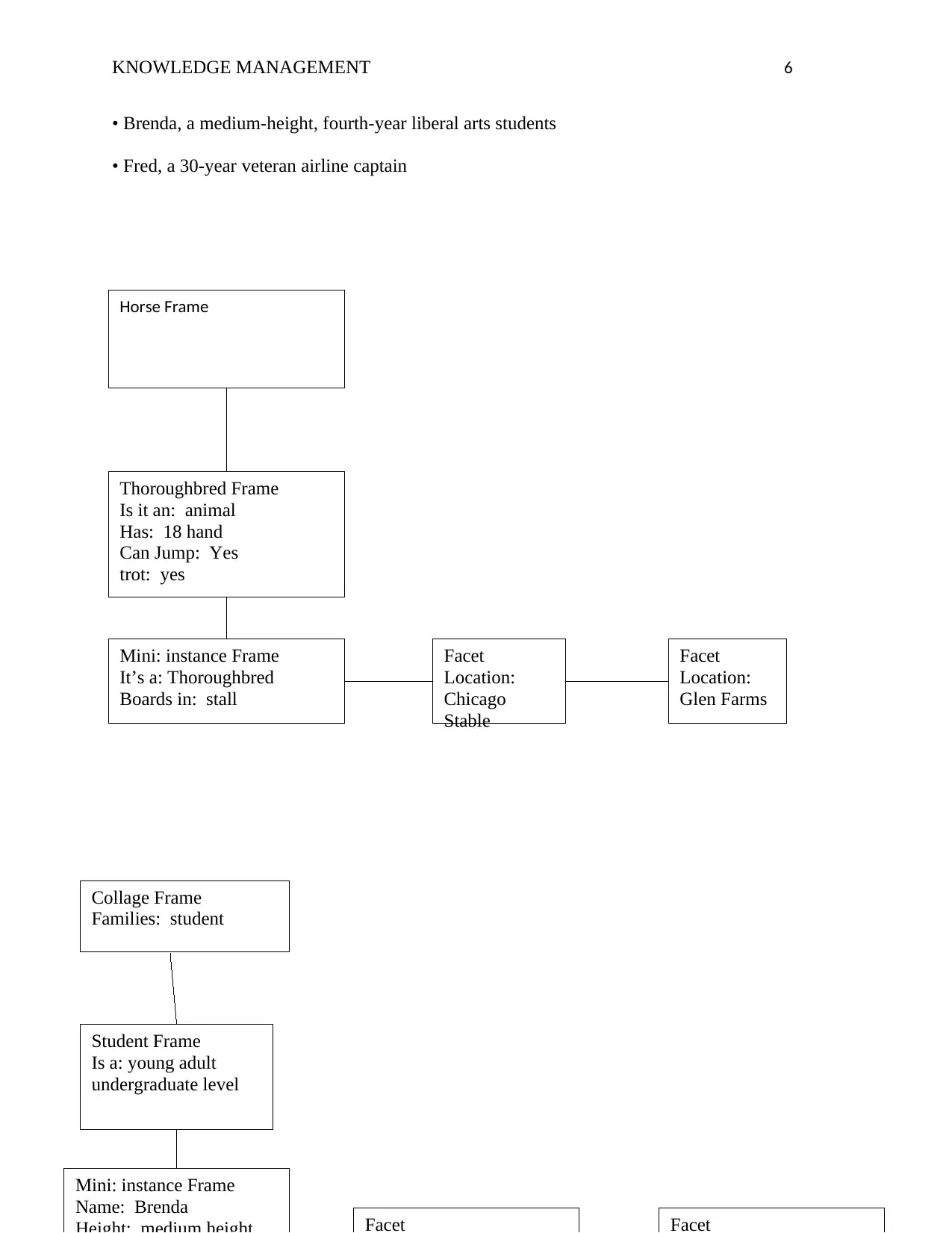
Horse Frame
Thoroughbred Frame
Is it an: animal
Has: 18 hand
Can Jump: Yes
trot: yes
Mini: instance Frame
It’s a: Thoroughbred
Boards in: stall
Facet
Location:
Chicago
Stable
Facet
Location:
Glen Farms
Collage Frame
Families: student
Student Frame
Is a: young adult
undergraduate level
Mini: instance Frame
Name: Brenda Facet Facet
KNOWLEDGE MANAGEMENT 6
• Brenda, a medium-height, fourth-year liberal arts students
• Fred, a 30-year veteran airline captain
Thoroughbred Frame
Is it an: animal
Has: 18 hand
Can Jump: Yes
trot: yes
Mini: instance Frame
It’s a: Thoroughbred
Boards in: stall
Facet
Location:
Chicago
Stable
Facet
Location:
Glen Farms
Collage Frame
Families: student
Student Frame
Is a: young adult
undergraduate level
Mini: instance Frame
Name: Brenda Facet Facet
KNOWLEDGE MANAGEMENT 6
• Brenda, a medium-height, fourth-year liberal arts students
• Fred, a 30-year veteran airline captain
⊘ This is a preview!⊘
Do you want full access?
Subscribe today to unlock all pages.

Trusted by 1+ million students worldwide
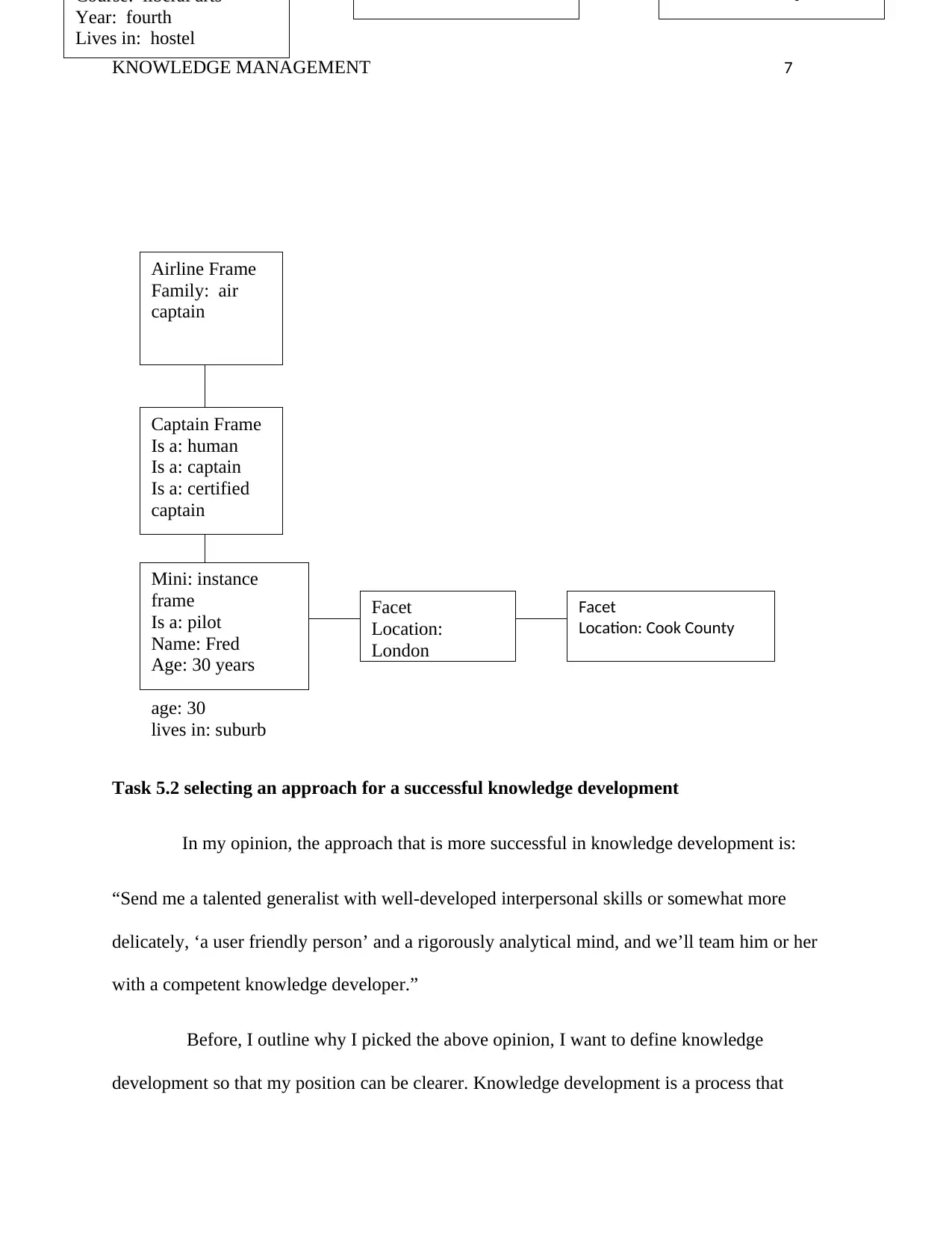
Course: liberal arts
Year: fourth
Lives in: hostel
Airline Frame
Family: air
captain
Captain Frame
Is a: human
Is a: captain
Is a: certified
captain
Mini: instance
frame
Is a: pilot
Name: Fred
Age: 30 years
age: 30
lives in: suburb
Facet
Location:
London
Facet
Location: Cook County
KNOWLEDGE MANAGEMENT 7
Task 5.2 selecting an approach for a successful knowledge development
In my opinion, the approach that is more successful in knowledge development is:
“Send me a talented generalist with well-developed interpersonal skills or somewhat more
delicately, ‘a user friendly person’ and a rigorously analytical mind, and we’ll team him or her
with a competent knowledge developer.”
Before, I outline why I picked the above opinion, I want to define knowledge
development so that my position can be clearer. Knowledge development is a process that
Year: fourth
Lives in: hostel
Airline Frame
Family: air
captain
Captain Frame
Is a: human
Is a: captain
Is a: certified
captain
Mini: instance
frame
Is a: pilot
Name: Fred
Age: 30 years
age: 30
lives in: suburb
Facet
Location:
London
Facet
Location: Cook County
KNOWLEDGE MANAGEMENT 7
Task 5.2 selecting an approach for a successful knowledge development
In my opinion, the approach that is more successful in knowledge development is:
“Send me a talented generalist with well-developed interpersonal skills or somewhat more
delicately, ‘a user friendly person’ and a rigorously analytical mind, and we’ll team him or her
with a competent knowledge developer.”
Before, I outline why I picked the above opinion, I want to define knowledge
development so that my position can be clearer. Knowledge development is a process that
Paraphrase This Document
Need a fresh take? Get an instant paraphrase of this document with our AI Paraphraser
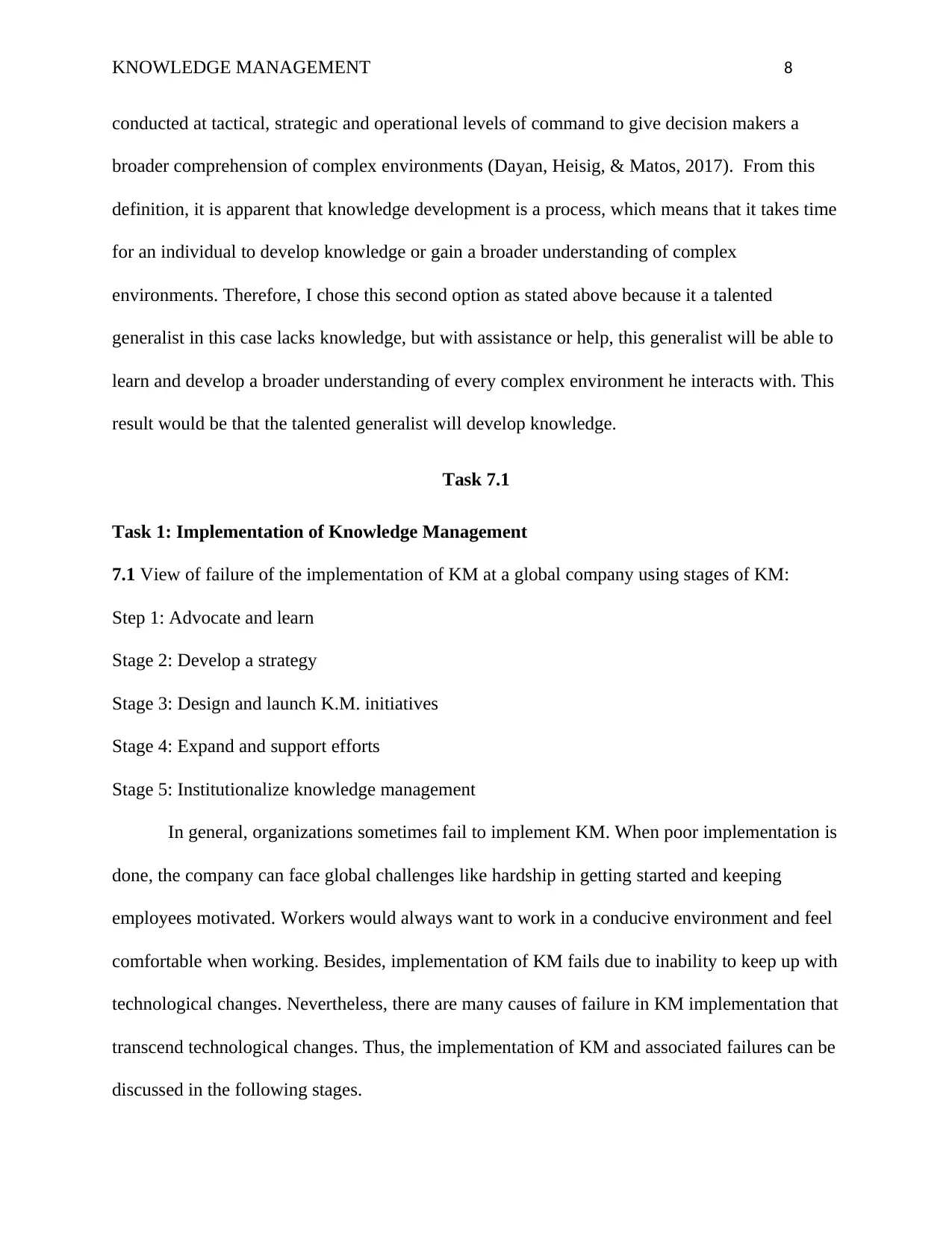
KNOWLEDGE MANAGEMENT 8
conducted at tactical, strategic and operational levels of command to give decision makers a
broader comprehension of complex environments (Dayan, Heisig, & Matos, 2017). From this
definition, it is apparent that knowledge development is a process, which means that it takes time
for an individual to develop knowledge or gain a broader understanding of complex
environments. Therefore, I chose this second option as stated above because it a talented
generalist in this case lacks knowledge, but with assistance or help, this generalist will be able to
learn and develop a broader understanding of every complex environment he interacts with. This
result would be that the talented generalist will develop knowledge.
Task 7.1
Task 1: Implementation of Knowledge Management
7.1 View of failure of the implementation of KM at a global company using stages of KM:
Step 1: Advocate and learn
Stage 2: Develop a strategy
Stage 3: Design and launch K.M. initiatives
Stage 4: Expand and support efforts
Stage 5: Institutionalize knowledge management
In general, organizations sometimes fail to implement KM. When poor implementation is
done, the company can face global challenges like hardship in getting started and keeping
employees motivated. Workers would always want to work in a conducive environment and feel
comfortable when working. Besides, implementation of KM fails due to inability to keep up with
technological changes. Nevertheless, there are many causes of failure in KM implementation that
transcend technological changes. Thus, the implementation of KM and associated failures can be
discussed in the following stages.
conducted at tactical, strategic and operational levels of command to give decision makers a
broader comprehension of complex environments (Dayan, Heisig, & Matos, 2017). From this
definition, it is apparent that knowledge development is a process, which means that it takes time
for an individual to develop knowledge or gain a broader understanding of complex
environments. Therefore, I chose this second option as stated above because it a talented
generalist in this case lacks knowledge, but with assistance or help, this generalist will be able to
learn and develop a broader understanding of every complex environment he interacts with. This
result would be that the talented generalist will develop knowledge.
Task 7.1
Task 1: Implementation of Knowledge Management
7.1 View of failure of the implementation of KM at a global company using stages of KM:
Step 1: Advocate and learn
Stage 2: Develop a strategy
Stage 3: Design and launch K.M. initiatives
Stage 4: Expand and support efforts
Stage 5: Institutionalize knowledge management
In general, organizations sometimes fail to implement KM. When poor implementation is
done, the company can face global challenges like hardship in getting started and keeping
employees motivated. Workers would always want to work in a conducive environment and feel
comfortable when working. Besides, implementation of KM fails due to inability to keep up with
technological changes. Nevertheless, there are many causes of failure in KM implementation that
transcend technological changes. Thus, the implementation of KM and associated failures can be
discussed in the following stages.
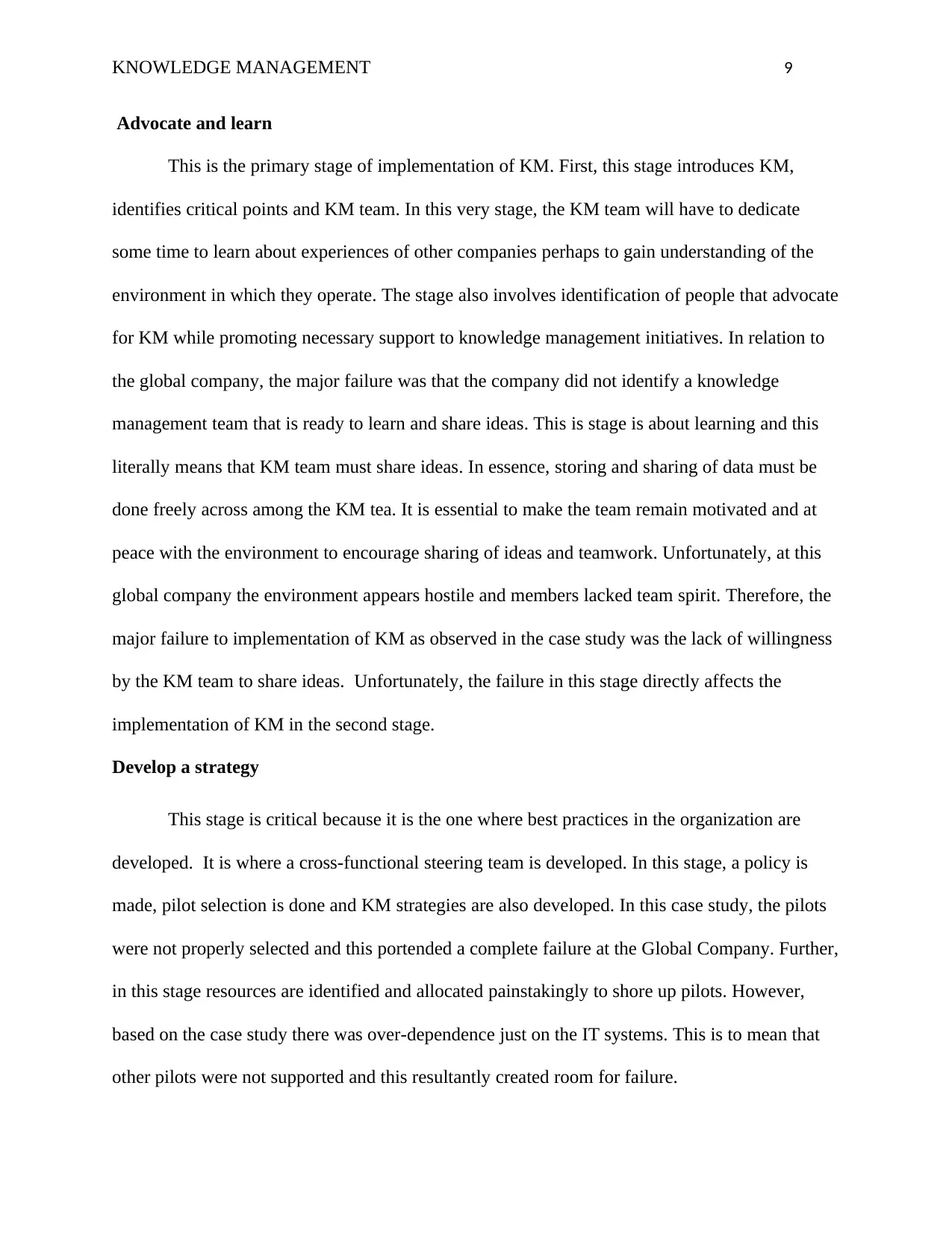
KNOWLEDGE MANAGEMENT 9
Advocate and learn
This is the primary stage of implementation of KM. First, this stage introduces KM,
identifies critical points and KM team. In this very stage, the KM team will have to dedicate
some time to learn about experiences of other companies perhaps to gain understanding of the
environment in which they operate. The stage also involves identification of people that advocate
for KM while promoting necessary support to knowledge management initiatives. In relation to
the global company, the major failure was that the company did not identify a knowledge
management team that is ready to learn and share ideas. This is stage is about learning and this
literally means that KM team must share ideas. In essence, storing and sharing of data must be
done freely across among the KM tea. It is essential to make the team remain motivated and at
peace with the environment to encourage sharing of ideas and teamwork. Unfortunately, at this
global company the environment appears hostile and members lacked team spirit. Therefore, the
major failure to implementation of KM as observed in the case study was the lack of willingness
by the KM team to share ideas. Unfortunately, the failure in this stage directly affects the
implementation of KM in the second stage.
Develop a strategy
This stage is critical because it is the one where best practices in the organization are
developed. It is where a cross-functional steering team is developed. In this stage, a policy is
made, pilot selection is done and KM strategies are also developed. In this case study, the pilots
were not properly selected and this portended a complete failure at the Global Company. Further,
in this stage resources are identified and allocated painstakingly to shore up pilots. However,
based on the case study there was over-dependence just on the IT systems. This is to mean that
other pilots were not supported and this resultantly created room for failure.
Advocate and learn
This is the primary stage of implementation of KM. First, this stage introduces KM,
identifies critical points and KM team. In this very stage, the KM team will have to dedicate
some time to learn about experiences of other companies perhaps to gain understanding of the
environment in which they operate. The stage also involves identification of people that advocate
for KM while promoting necessary support to knowledge management initiatives. In relation to
the global company, the major failure was that the company did not identify a knowledge
management team that is ready to learn and share ideas. This is stage is about learning and this
literally means that KM team must share ideas. In essence, storing and sharing of data must be
done freely across among the KM tea. It is essential to make the team remain motivated and at
peace with the environment to encourage sharing of ideas and teamwork. Unfortunately, at this
global company the environment appears hostile and members lacked team spirit. Therefore, the
major failure to implementation of KM as observed in the case study was the lack of willingness
by the KM team to share ideas. Unfortunately, the failure in this stage directly affects the
implementation of KM in the second stage.
Develop a strategy
This stage is critical because it is the one where best practices in the organization are
developed. It is where a cross-functional steering team is developed. In this stage, a policy is
made, pilot selection is done and KM strategies are also developed. In this case study, the pilots
were not properly selected and this portended a complete failure at the Global Company. Further,
in this stage resources are identified and allocated painstakingly to shore up pilots. However,
based on the case study there was over-dependence just on the IT systems. This is to mean that
other pilots were not supported and this resultantly created room for failure.
⊘ This is a preview!⊘
Do you want full access?
Subscribe today to unlock all pages.

Trusted by 1+ million students worldwide
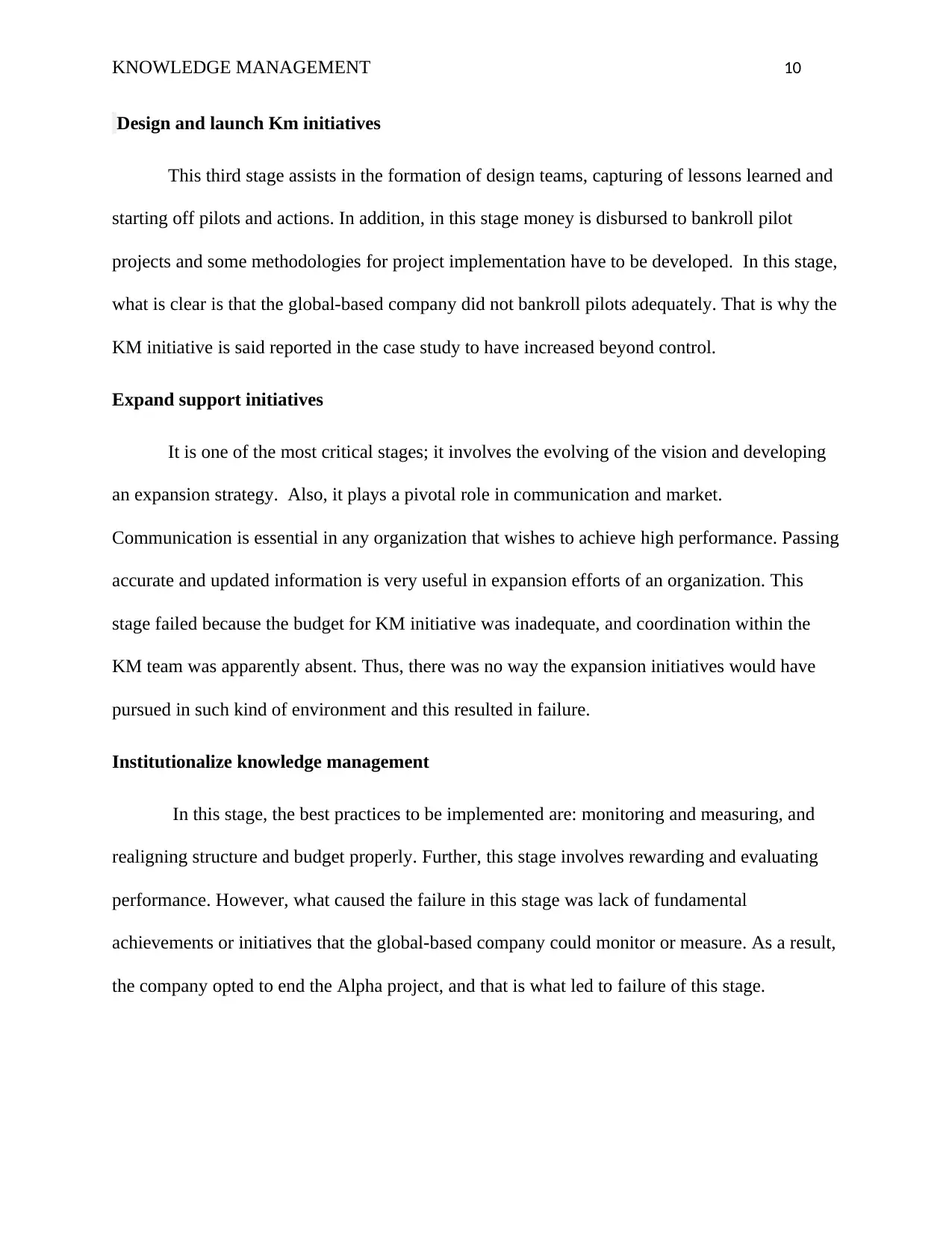
KNOWLEDGE MANAGEMENT 10
Design and launch Km initiatives
This third stage assists in the formation of design teams, capturing of lessons learned and
starting off pilots and actions. In addition, in this stage money is disbursed to bankroll pilot
projects and some methodologies for project implementation have to be developed. In this stage,
what is clear is that the global-based company did not bankroll pilots adequately. That is why the
KM initiative is said reported in the case study to have increased beyond control.
Expand support initiatives
It is one of the most critical stages; it involves the evolving of the vision and developing
an expansion strategy. Also, it plays a pivotal role in communication and market.
Communication is essential in any organization that wishes to achieve high performance. Passing
accurate and updated information is very useful in expansion efforts of an organization. This
stage failed because the budget for KM initiative was inadequate, and coordination within the
KM team was apparently absent. Thus, there was no way the expansion initiatives would have
pursued in such kind of environment and this resulted in failure.
Institutionalize knowledge management
In this stage, the best practices to be implemented are: monitoring and measuring, and
realigning structure and budget properly. Further, this stage involves rewarding and evaluating
performance. However, what caused the failure in this stage was lack of fundamental
achievements or initiatives that the global-based company could monitor or measure. As a result,
the company opted to end the Alpha project, and that is what led to failure of this stage.
Design and launch Km initiatives
This third stage assists in the formation of design teams, capturing of lessons learned and
starting off pilots and actions. In addition, in this stage money is disbursed to bankroll pilot
projects and some methodologies for project implementation have to be developed. In this stage,
what is clear is that the global-based company did not bankroll pilots adequately. That is why the
KM initiative is said reported in the case study to have increased beyond control.
Expand support initiatives
It is one of the most critical stages; it involves the evolving of the vision and developing
an expansion strategy. Also, it plays a pivotal role in communication and market.
Communication is essential in any organization that wishes to achieve high performance. Passing
accurate and updated information is very useful in expansion efforts of an organization. This
stage failed because the budget for KM initiative was inadequate, and coordination within the
KM team was apparently absent. Thus, there was no way the expansion initiatives would have
pursued in such kind of environment and this resulted in failure.
Institutionalize knowledge management
In this stage, the best practices to be implemented are: monitoring and measuring, and
realigning structure and budget properly. Further, this stage involves rewarding and evaluating
performance. However, what caused the failure in this stage was lack of fundamental
achievements or initiatives that the global-based company could monitor or measure. As a result,
the company opted to end the Alpha project, and that is what led to failure of this stage.
Paraphrase This Document
Need a fresh take? Get an instant paraphrase of this document with our AI Paraphraser
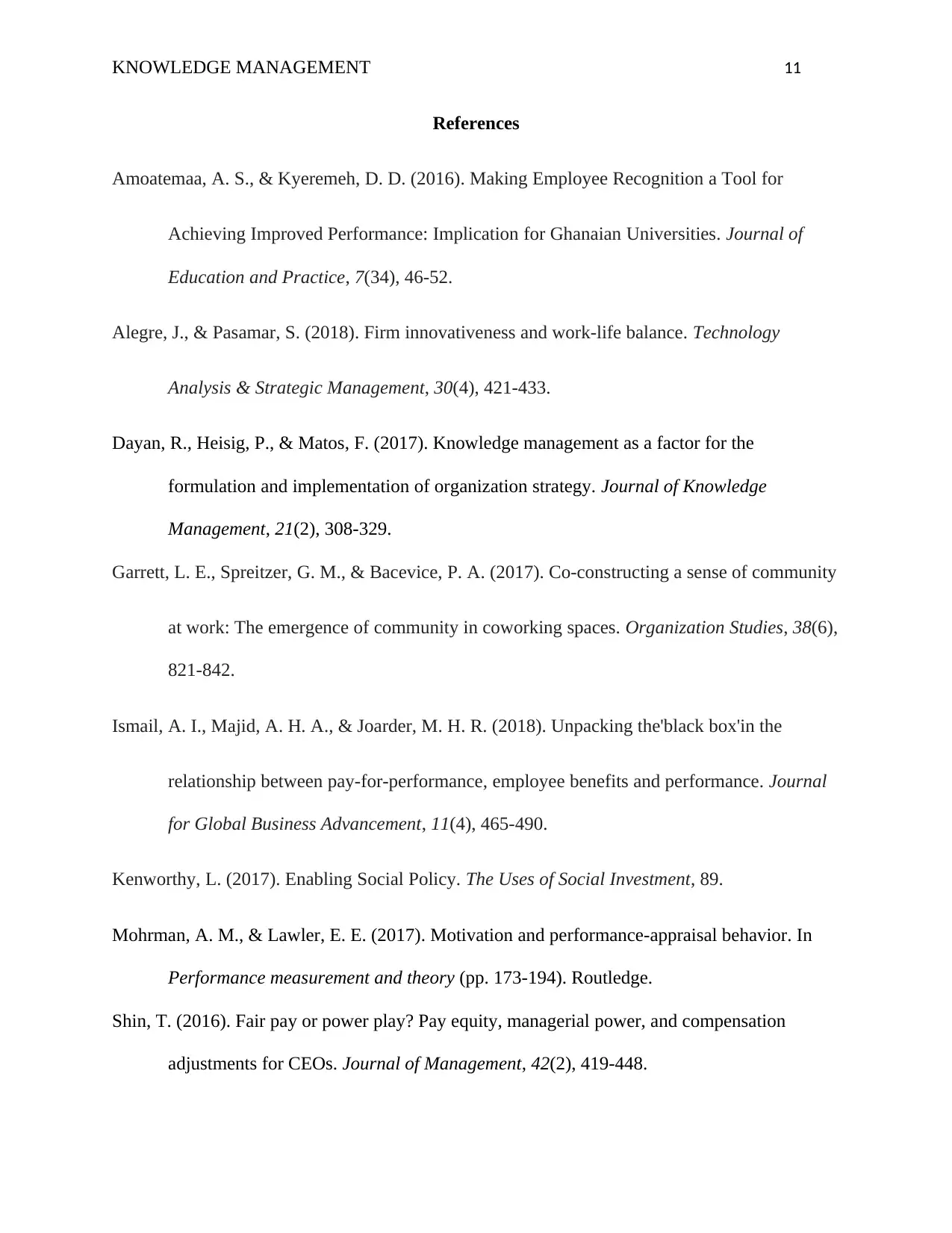
KNOWLEDGE MANAGEMENT 11
References
Amoatemaa, A. S., & Kyeremeh, D. D. (2016). Making Employee Recognition a Tool for
Achieving Improved Performance: Implication for Ghanaian Universities. Journal of
Education and Practice, 7(34), 46-52.
Alegre, J., & Pasamar, S. (2018). Firm innovativeness and work-life balance. Technology
Analysis & Strategic Management, 30(4), 421-433.
Dayan, R., Heisig, P., & Matos, F. (2017). Knowledge management as a factor for the
formulation and implementation of organization strategy. Journal of Knowledge
Management, 21(2), 308-329.
Garrett, L. E., Spreitzer, G. M., & Bacevice, P. A. (2017). Co-constructing a sense of community
at work: The emergence of community in coworking spaces. Organization Studies, 38(6),
821-842.
Ismail, A. I., Majid, A. H. A., & Joarder, M. H. R. (2018). Unpacking the'black box'in the
relationship between pay-for-performance, employee benefits and performance. Journal
for Global Business Advancement, 11(4), 465-490.
Kenworthy, L. (2017). Enabling Social Policy. The Uses of Social Investment, 89.
Mohrman, A. M., & Lawler, E. E. (2017). Motivation and performance-appraisal behavior. In
Performance measurement and theory (pp. 173-194). Routledge.
Shin, T. (2016). Fair pay or power play? Pay equity, managerial power, and compensation
adjustments for CEOs. Journal of Management, 42(2), 419-448.
References
Amoatemaa, A. S., & Kyeremeh, D. D. (2016). Making Employee Recognition a Tool for
Achieving Improved Performance: Implication for Ghanaian Universities. Journal of
Education and Practice, 7(34), 46-52.
Alegre, J., & Pasamar, S. (2018). Firm innovativeness and work-life balance. Technology
Analysis & Strategic Management, 30(4), 421-433.
Dayan, R., Heisig, P., & Matos, F. (2017). Knowledge management as a factor for the
formulation and implementation of organization strategy. Journal of Knowledge
Management, 21(2), 308-329.
Garrett, L. E., Spreitzer, G. M., & Bacevice, P. A. (2017). Co-constructing a sense of community
at work: The emergence of community in coworking spaces. Organization Studies, 38(6),
821-842.
Ismail, A. I., Majid, A. H. A., & Joarder, M. H. R. (2018). Unpacking the'black box'in the
relationship between pay-for-performance, employee benefits and performance. Journal
for Global Business Advancement, 11(4), 465-490.
Kenworthy, L. (2017). Enabling Social Policy. The Uses of Social Investment, 89.
Mohrman, A. M., & Lawler, E. E. (2017). Motivation and performance-appraisal behavior. In
Performance measurement and theory (pp. 173-194). Routledge.
Shin, T. (2016). Fair pay or power play? Pay equity, managerial power, and compensation
adjustments for CEOs. Journal of Management, 42(2), 419-448.

KNOWLEDGE MANAGEMENT 12
⊘ This is a preview!⊘
Do you want full access?
Subscribe today to unlock all pages.

Trusted by 1+ million students worldwide
1 out of 12
Related Documents
Your All-in-One AI-Powered Toolkit for Academic Success.
+13062052269
info@desklib.com
Available 24*7 on WhatsApp / Email
![[object Object]](/_next/static/media/star-bottom.7253800d.svg)
Unlock your academic potential
Copyright © 2020–2025 A2Z Services. All Rights Reserved. Developed and managed by ZUCOL.





